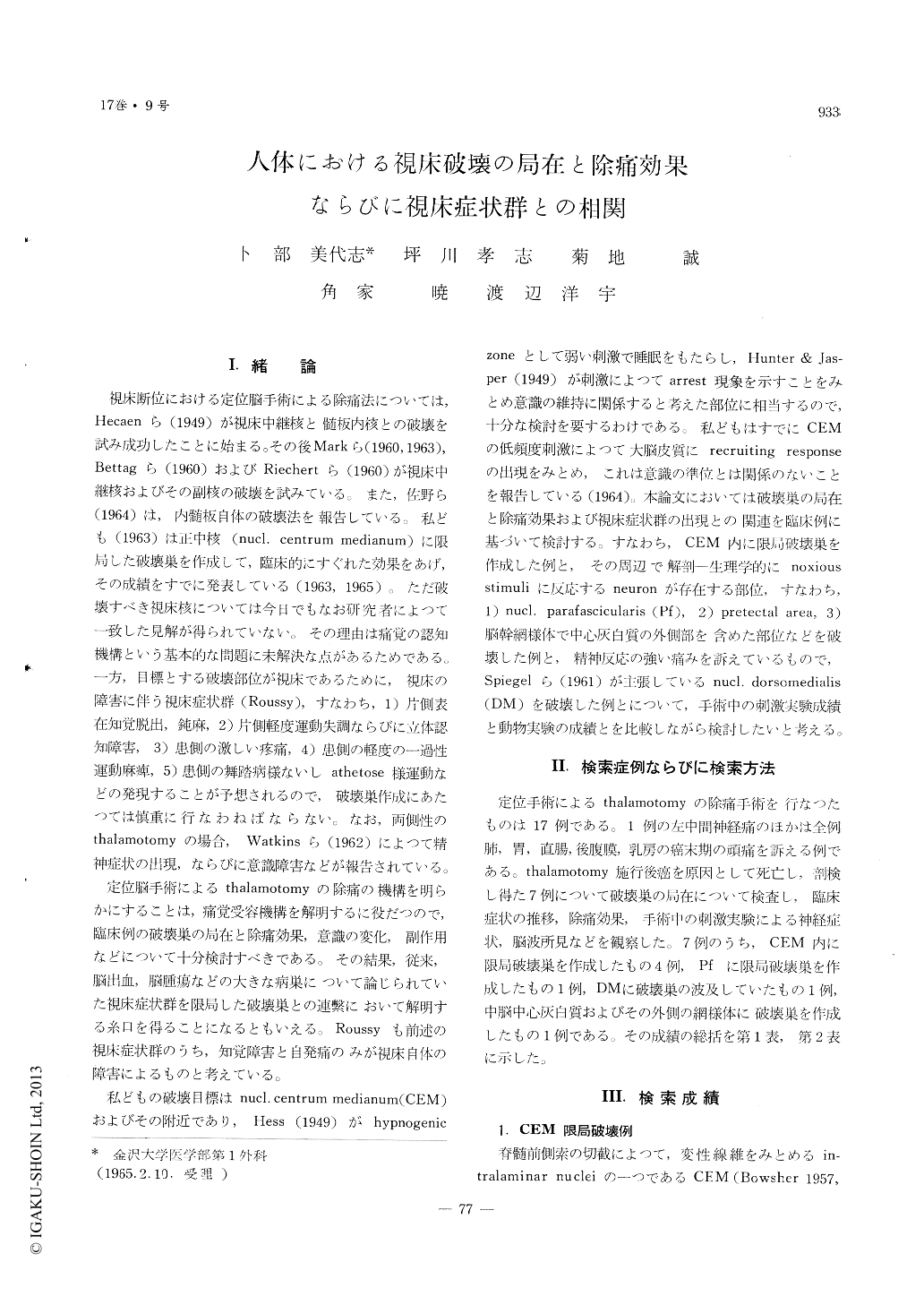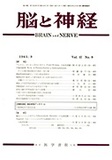Japanese
English
- 有料閲覧
- Abstract 文献概要
- 1ページ目 Look Inside
I.緒論
視床断位における定位脳手術による除痛法については,Hecaenら(1949)が視床中継核と髄板内核との破壊を試み成功したことに始まる。その後Markら(1960,1963),Bettagら(1960)およびRiechertら(1960)が視床中継核およびその副核の破壊を試みている。また,佐野ら(1964)は,内髄板自体の破壊法を報告している。私ども(1963)は正中核(nucl. centrum medianum)に限局した破壊巣を作成して,臨床的にすぐれた効果をあげ,その成績をすでに発表している(1963,1965)。ただ破壊すべき視床核については今日でもなお研究者によつて一致した見解が得られていない。その理由は痛覚の認知機構という基本的な問題に未解決な点があるためである。一方,目標とする破壊部位が視床であるために,視床の障害に伴う視床症状群(Roussy),すなわち,1)片側表在知覚脱出,鈍麻,2)片側軽度運動失調ならびに立体認知障害,3)患側の激しい疼痛,4)患側の軽度の一過性運動麻痺,5)患側の舞踏病様ないしathetose様運動などの発現することが予想されるので,破壊巣作成にあたつては慎重に行なわねばならない。なお,両側性のthalamotomyの場合,Watkinsら(1962)によつて精神症状の出現,ならびに意識障害などが報告されている。
定位脳手術によるthalamotomyの除痛の機構を明らかにすることは,痛覚受容機構を解明するに役だつので,臨床例の破壊巣の局在と除痛効果,意識の変化,副作用などについて十分検討すべきである。その結果,従来,脳出血,脳腫瘍などの大きな病巣について論じられていた視床症状群を限局した破壊巣との連繋において解明する糸口を得ることになるともいえる。Roussyも前述の視床症状群のうち,知覚障害と自発痛のみが視床自体の障害によるものと考えている。
The authors have devised thalamotomy which made stereotaxically the lesion in the nucl. centrum medianum for the relief of the intractable pain and performed this operation in 17 human cases. Autopsies were done in 7 cases, died of the original disease. The lesions were traced in these cases and relation of the lesion site to the appearance of the thalamic syndrome and the effect on the relief of pain was observed.
1) In the case of destruction of the nucl. centrum medianum (CEM) on both sides, no particular ma-nifestation was seen except for a transient hypesthe-sia on the skin surface. The pain was completely relieved without recurrence until the patient died of the original disease. No change in the consciousness and the electroencephalographic finding was recogni-sed after the operation.
2) In the case of destruction of the nucl. parafa-scicularis (Pf) and the pretectal area on one side, a transient hypesthesia was seen on the skin surface, an involuntary movement on the ipsilateral side and a rigidity on the contralateral side. The patient fell into a slight lethargy and became mutism for 2 weeks after the operation. The elecroencephalogram show-ed the slow wave pattern. The pain was completely relieved.
3) After making the lesion in the central grey matter in the midbrain and the reticular formation situated on the lateral side, illusion appeared being accompanied by a confusion of the consciousness and unskillfully of the extremity motion was seen on the ipsilateral side. The patient became mutism. The electroencephalogram showed a slow wave pattern. Relief from the intractable pain was insufficiently obtained showing a transient effect.
4) After destruction of the bilateral nucl. dorso-medialis (DM), there were observed a transient hy-pesthesia of superficial sensation, an excessive action and a declining apprehension. Sometimes the patient spoke a meaningless word. The electroencephalogram showed 0-wave sporadically. The effect on the relief of pain could not be traced by destruction of the nucl. dorsomedialis (DM) alone.
In summarizing the results, it was known that the lesion strictly localised in the nucl. centrum medi-anum (CEM), particularly, in its poste ventral part, exerted a striking effect to relieve the intractable pain without a hazard of the side-effect. That is, destruction of CEM on both sides caused no change of the consciousness and the electroencephalogram. CEM-thalamotomy indicates a new proceeding in the field of pain operation.

Copyright © 1965, Igaku-Shoin Ltd. All rights reserved.


